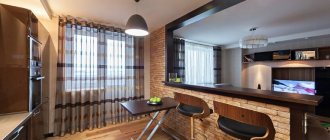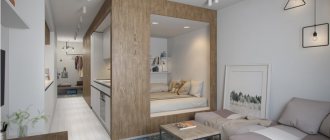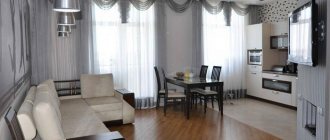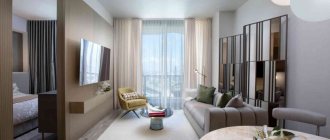- June 7, 2019
- Repair Tips
- Catherine
Studios are a widely sought-after type of housing. This is largely due to the cost - apartments with this layout are 10-15% cheaper than classic one-room apartments with the same area. In addition, the absence of a partition makes the space more functional and gives scope for design solutions. However, in this case, the question of how to separate the kitchen from the room in the studio becomes relevant.
Types of divisions
Before you begin interior design, you should determine how to zone the space. Each of the existing options has its own features and characteristics. In this case, you must first take into account the lifestyle and requirements of the apartment residents.
- Partitions. The installation of plasterboard partitions does not have to be coordinated with the authorities, while the design can clearly divide the studio into 2 independent rooms: a room and a kitchen. An accordion screen has the same effect.
- Use of furniture. Despite the fact that there will be no actual partition, space is demarcated in the interior. In this case, you can achieve both a smooth flow of the kitchen into the dining area and isolation of the rooms. A sofa, bar counter, table, or wardrobe can serve as a zoning element.
- Separation using visual effects. In this case, the room will be single, but finishing materials of different colors and textures will be used in the room and kitchen. This can save space, but this option is not suitable in every case.
- Difference in floor or ceiling height. As in the previous case, there is no partition between the rooms.
Legitimation
Some options for dividing the kitchen and living room require approval and legalization. If the kitchen and living room were not originally one room, then when demolishing an interior wall, you need to make sure that the wall is not load-bearing. In this case, you will need to draw up a redevelopment project and contact the appropriate authority. Coordination will also be required if you choose to zone the kitchen and living room with a partition that is not removable.
What should you consider when choosing?
When choosing the interior of a room and kitchen in a studio, you should consider several nuances:
- A small studio should have a minimum of furniture, so only the most necessary interior details remain in the kitchen area.
- For those who often dine at home with their family, it is best to choose a dining table instead of a bar counter. If there is not enough space, it can be a folding or folding model.
- For busy people who often eat at an office buffet or cafe, interior designers advise purchasing a bar counter and a minimum of kitchen furniture. A hob, cabinet and countertop of 60-80 cm will be enough.
- When using a gas stove, there must be a partition in the kitchen - these are regulatory requirements.
Island
Great idea for spacious studios. The island is a free-standing kitchen cabinet, away from the walls and furniture. It is part of the storage system, acts as a dining table, and also separates the kitchen and living areas.
Hang lamps above the island to further zone the space with light.
Using a partition
You can separate the kitchen area in the studio using a partition. This design is most often made of plasterboard. Even a non-professional can handle the installation. The doorway can be made in a classic rectangular shape. A more creative option would be an arched or any other curved passage.
The advantage of such a partition is that the kitchen will become an independent room. In addition, fewer odors from cooking will enter the room. However, there are also disadvantages to such zoning. Additional space will be required to arrange the partition. For this reason, this option is not suitable for small apartments. You should not choose this method in cases where there is no window in the kitchen area.
As an alternative, you can consider wide sliding doors or accordion doors. Such designs can close and open the kitchen space. When open, they slide along the wall or cabinet.
Design options and choice of colors
The choice of material can be based on the preferences of the hostess and the overall design of the room, but it is very important that the fabrics are the same for both sides. The difference in the texture of the fabric and the type of cornice will make the room untidy.
The texture of the fabrics should be the same for both zones.
Loft
Most modern curtains are suitable for a rough loft style. But they should have a laconic appearance, without folds, decorative tiebacks or lambrequins.
Simple curtains without intricate decorations are suitable for a loft.
It is better to choose a warm color for the curtains for a room in this design - brown, sand, beige, burgundy, ecru, in order to slightly soften the typical loft bricks, untreated wood, cement surfaces, chrome parts and dark tones.
Having chosen fabrics and colors, you need to decide on a design solution. If long curtains that flow freely from the ceiling fit organically into the living room, then in the kitchen-dining room you can make short curtains, Roman blinds, or fabric blinds from the same material.
Curtains can be either long or short.
Classic
The classic design of the room leaves a lot of room for imagination when it comes to choosing curtains for the windows. The fabric can be either natural or synthetic and can drape well. It is better to complement heavy curtains with a tulle curtain or stripes of organza or chiffon.
In the classics there is room to show your imagination.
Rooms in which the living room is decorated with long curtains with tulle reaching to the floor, mounted on tiebacks or wall hooks, look good, and the kitchen area has blinds or Roman blinds made from the same materials. In the dining part of the room, a very short lambrequin on a cornice, which can be combined with curtains made of the same fabric, will also look stylish.
In the classic style, you can use tiebacks, lambrequins and add tulle to the curtains.
High tech
The main requirement of this style is practicality and the absence of decorative details. Therefore, high-tech curtains must be strict in shape and fulfill their main functions - to cover the window from light and prying eyes.
High-tech style is characterized by practicality and lack of decor.
All synthetic modern materials are suitable for this style. The color can be pure white, gray or other cold shades; the use of prints is not allowed.
In the high-tech style, curtains should be strict and functional, in solid colors.
The living and dining areas can be combined with the same curtains, but different in length.
You can also use Roman plain blinds, the same for both sides of the room, or Japanese sliding panels without patterns on one cornice along the entire wall.
Roman plain curtains would be appropriate.
Country
The design of the entire room in a “village” style allows for the widespread use of flower prints, wicker and wooden furniture, accessories and additions made of natural wood. The overall style of the room looks bright, cheerful, comfortable, reminiscent of summer and country coziness. These curtains are easy to sew with your own hands.
Bright colors and floral prints are the characteristic features of country style.
Curtains in country style can be short or long, but always with an abundance of gathers and folds, with ruffles and lace inserts.
Curtains for both zones can be made small, on wooden cornices. They are often decorated with checkered or striped fabric, stripes of lace, hems, crocheted borders, etc. Rough burlap looks very organic in combination with colorful natural fabrics or cambric curtains.
You can use curtains made of lace and other lightweight materials.
Although rustic-style prints are acceptable and logical, you should not use bright colors or large patterns - these quickly become boring and even begin to irritate. It is appropriate to choose pastel shades and muted tones on a white or milky background so as not to overload the overall look of the room.
You should not choose too bright colors for prints, they can quickly get boring.
Keep in mind! The choice of curtains with prints in the form of flowers, polka dots, small or large checks in country style should be limited to only one pattern, and not combine several types of prints in one room, which designers recognize as the height of bad taste.
In country music, only one type of pattern is allowed.
Bar counter in the interior
If in spacious studios the selection of furniture for the kitchen most often does not cause difficulties, then in small apartments this issue is extremely acute. In European countries, a bar counter has been used in home interiors for a long time. In the post-Soviet space, such a detail has gained popularity relatively recently.
In studios, a stand can be called one of the best acquisitions, as it is as functional as possible. In addition, with such a detail the interior becomes stylish and original.
When choosing a stand, you should take into account the number of family members and the size of the room. The most compact option is a countertop that separates the kitchen and living room. In addition to it, you only need a few chairs.
This design can be slightly modified and cabinets can be added at the bottom. With this approach, it is possible to rationally use every centimeter of space. An add-on can also be made at the top of the bar in the form of a hanging system for storing wine glasses and glasses.
WALL BETWEEN KITCHEN AND LIVING ROOM
The most radical solution separating the kitchen from the living room is creating a solid wall, for example, from plasterboard. However, such partitions are increasingly deviating from the traditional form. Today, designs made of glass modules in steel frames are very popular; everything looks light and stylish and gives the interior a modern character.
A kitchen separated by a wall from the living room with this arrangement works mainly in large areas; in a small kitchen it is better to abandon glazing and install it only on a frame structure. This type of kitchen screen is designed for modern, minimalist, Scandinavian and industrial interiors. They are sometimes also used in English style kitchens.
Dinner table
When choosing how to separate the kitchen from the room in the studio, do not forget about the tables. As in the case of a stand, this option will not only allow you to divide the room into zones, but will also become a functional detail. In this case, the kitchen area will smoothly flow into the dining and living room.
The advantage of this option is that it is suitable for any interior style.
Interesting ideas for separating the kitchen from the living room
- Peninsula, island, table . Although these elements reach just over 1 meter, they can become a noticeable barrier to organization, although of course their social role is one of unification rather than division. Designating such a boundary or transition zone between the kitchen, dining room and living room will work well in rooms with a large area and anywhere where it is worth leaving a natural pull between the space for cooking, eating and relaxing.
- Openwork veil . Openwork decoration is an interesting design element, especially if you choose the right lighting. Translucent rays of the sun or light enhance this effect. The lightweight design means the compartment also works well in a small area. The compartment is used throughout the entire height, so the division of space is very clear.
- Glass curtain - glass is a very good finishing material. It has a lightweight design that reflects light and is therefore suitable for use in small spaces. Glass can be transparent, milky or have patterns that match the style of the kitchen.
- Furniture and sofa. Furniture can be a great way to separate the kitchen from the living room. You can opt for tall and simple shapes or low, more attractive furniture. It will be a beautiful decoration for both rooms and, in addition, will become such a “thin border” between the rooms. For separation, you can also use a sofa, which, in addition to its original function, will effectively separate the kitchen from the living room.
When considering options for separating the kitchen from the living room, consider wooden sliding doors. They will look good in a variety of styles - natural material will complement a classic interior, enrich vintage decor, and also diversify a modern or Scandinavian interior. Moving doors can also be glass - transparent, frosted, mirrored or with spectacular patterns.
Rack as a zoning element
Shelving looks no less impressive in small studio rooms with a kitchen. To give the interior lightness, it is better to choose models without a back wall. In this case, the shelves will be as open as possible and will be accessible from both the kitchen and the room.
This piece of furniture can also be used to visually expand the space. In this case, it is worth purchasing a rack made of a metal base and glass.
TV wall between kitchen and living room
It’s worth considering a TV wall during your kitchen renovation. Then the easiest way is to install a wall that will separate the kitchen from the living room. From the living room it will serve as a TV wall, and on the other side, from the kitchen side you can use it to hang additional cabinets or shelves. Lately, low TV walls separating the living room from the kitchen have become very popular. Thanks to this, the space is properly divided, and above the TV wall you can see what is happening in the kitchen.
Sofa
The most difficult thing is to decide how to furnish a studio room with a kitchen in a small apartment. As a worthy solution, designers recommend using a sofa. This piece of furniture would be especially appropriate in a bachelor’s apartment. In this case, the sofa will act as a zoning element, a relaxation area and a place to sleep.
In this case, the choice of model is limited only by the imagination of the apartment owner and the size of the room. Corner and island sofas look the most impressive.
Dining and sitting area
In the recreation area, that is, in the living room, you can let your imagination and invention run wild. In this room you can use various types and types of materials and colors, the main thing is that they match the style and theme of this room. The windows can also be decorated with heavy curtains made of natural linen - the room will be fresher, cozy and bright.
If you want to add solemnity to the design, then in addition to curtains you can use lambrequins, fringe, tails and other methods of decoration.
The balcony door in the hall can be curtained with Roman blinds. However, it may not be entirely convenient, since you will have to constantly raise the curtain every time you need to visit the balcony or always keep it rolled up.
A good alternative would be Japanese panels in the living room. They are as simple and relaxed as the Roman ones, only they are shifted to the side, which is very rational. Such screens are made to order according to individual measurements of windows with balcony doors. Such a protective screen will protect you from direct sunlight, turning it into diffused light. The room will not be darkened, but illuminated with diffuse, comfortable light.
If the dining table is near a window, then the openings are decorated with lighter shades, which promote appetite and better digestion.
You may also be interested in: Blinds for the kitchen - choosing practicality and beauty
The living room can be decorated with curtains with tulle. Length in this zone does not matter. But the curtains should resonate with the seating area. To choose curtains for the living room, you need to consider some recommendations:
- Relationship with the kitchen.
- The degree of illumination and dimensions of the recreation area.
- The style and theme in which the room is designed.
Podium
With the help of this design technique, even the most boring interior can be turned into a modern and stylish one. In addition, for a room with a kitchen in a Khrushchev studio, you can choose countless design options. Spot lighting will help to place accents in the interior.
Builders note that this zoning option will require additional investments, as building materials will be needed. In addition, not every beginner can handle the installation of an elevation; therefore, hired specialists will be required, whose work will also need to be paid.
Another disadvantage is the height difference itself. This is especially true for those apartments where there are elderly people and small children.
Stretch multi-level ceiling
As with the podium, a ceiling with different levels allows you to create the impression of transition from one area to another. However, before separating the studio room from the kitchen, it is worth considering the height of the ceilings. For rooms with high ceilings, you can choose designs reaching a height of 10 cm or more. As for Khrushchev apartments, the height difference in them should not exceed 5 cm. Otherwise, the ceiling will “press.”
This zoning allows you to solve several problems:
- hides ceiling unevenness (that is, does not require preliminary surface preparation);
- helps hide communications (in many new buildings, engineering systems run on top);
- makes it possible to make lighting spectacular.
Playing with color
Using different colors is another way to separate the studio room from the kitchen. In this case, the division is only visual, since the partition between the rooms is completely absent.
When choosing finishing materials for zoning, you should consider several features.
- When zoning with color, the texture of the materials should be the same. If wallpaper is chosen as a wall material, then it must be present in both zones. The same can be said about flooring.
- If a decision is made to use different finishes, the color must be identical. For example, in the kitchen area the floor can be covered with tiles, and in the room - with linoleum. At the same time, the color of such materials should be similar. This will make the transition more harmonious.
- Using one color scheme. Since dividing the studio into a kitchen and a room is necessary only visually (without a partition), it is very important to create a smooth transition. In other words, the room should be perceived as integral, but divided into separate functional areas. The easiest way to do this is to use shades from the same color range.
- Bright accents. When using bright colors, it is necessary to observe moderation. Designers advise using bright elements only in one area (most often this is the kitchen). Rooms designed in pastel colors (milk, peach, ivory) with bright details in the kitchen area look especially stylish. A kitchen apron, bar counter or kitchen façade can serve as a bright accent.
- Playing with color. Experienced designers advise using warmer colors for the dining area than in the living room. This makes the atmosphere more cozy and homely.
The advantage of this option is ease of execution and low financial investment. In other words, residents can easily cope with zoning on their own.
Light
An affordable way to divide space is lighting. Absolutely, the light should be distributed throughout all areas. Separate lighting in the kitchen, and the same in the living room. It will look great to divide the space with LED bulbs and lamps.
For the kitchen, placing the light in some protruding niche is suitable. For example, if there is a canopy or some kind of protruding wall in the kitchen, then you can add small spotlights there, and hang a large chandelier in the living room.
Zoning with curtains
Using curtains is one way to decorate a studio room with a kitchen. This method has several advantages:
- low price;
- ease and speed of installation;
- space saving (unlike partitions, curtains take up minimal space);
- versatility (this addition will suit any interior, the main thing is to choose the right curtain design);
- ease of use (curtains can be easily opened and closed).
When choosing curtains, you must take into account the specifics of the room. It is better not to use fabric curtains in the kitchen. This is explained by increased temperature and humidity, as well as the possibility of stubborn stains from grease and other products appearing.
For a classic interior, you should choose wide vertical blinds. Such options with wide slats visually resemble curtains, so they will fit organically into the room. In addition, blinds are more practical to use. Thanks to the special coating, the material does not absorb dirt and is easy to wash and clean.
Decorative options can be a worthy replacement for classic curtains. These can be designer plastic curtains made of beads, rings, plates or other shapes. They look impressive in any interior, you just need to choose the color scheme.
Colors and fabrics
Curtains for the kitchen-living room are chosen by the owners of the apartment. But it is worth remembering that you should not use too dark or too bright colors - they will visually reduce the space.
Low ceilings can be visually raised with curtains with vertical stripes. Materials of light and light shades will give the space freshness and lightness, giving a feeling of spaciousness.
Depending on the overall design style of the room, the color of the curtains can be bright or contrast with the overall decor and color of the furniture.
The choice of fabric for kitchens is of great importance: textiles should be easy to wash and not absorb odors. Heavy fabrics are not suitable for the kitchen because they absorb grease, dust, dirt and are difficult to clean. Everyone knows that it is necessary to do laundry as often as possible.
You need to choose curtains in shades close to the color wheel.
Save
Save
Save











